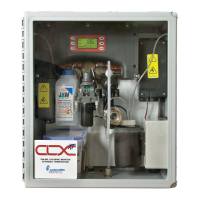CLX-XT (28652) Page 20
REV 5 (5/2020)
7.3 Configuring the RS–485 Port
The instrument is equipped with an RS 485 port which
operates in Simple bus or Modbus. Prompts will appear
for setting the baud rate, the address and the Modbus
transmission mode (RTU or ASCII).
Select the correct baud rate (1200, 2400, 4800, 9600, or
19200) for operation of the I/O port by pressing the or buttons to change the
displayed baud rate.
Press the button to continue on and select the desired
instrument address using the or buttons. Once the
selection is satisfactory, press the button.
To use the Modbus mode, select ASCII or RTU. See
section 8.1.2.
7.4 Configuring the Alarms
Two relays are provided that are designed to operate as two independent programmable
alarms or as a system problem alarm. Please note that changes to alarms will not be
recognized until the start of the next cycle. Two settings must be selected to fully program
each alarm:
1. The alarm function (HI, LO, OFF or Error)
2. The alarm set point (level at which the alarm activates)
These items are described below:
Alarm Function: The alarms can either be turned OFF or selected to operate in one of
three different manners:
1. HI alarm: the relay changes state when the measured chlorine level is higher than the
programmed alarm level (set point).
2. LO alarm: the relay changes state when the measured chlorine level is lower than the
programmed alarm level (set point).
3. Error alarm: If there is a system fault or problem the alarm will change states.
Alarm Set Point: The level at which an alarm activates is called the alarm set point. On
the instrument, the alarm set point is designated as “S/P”. The set point is adjustable to
any valid chlorine level over the range of the instrument in steps of 0.01 mg/L. This
setting is not available if the Error function is chosen.
7.4.1 Alarm 1
Alarm 1 Function: The ALM1 is displayed and the display indicates the current
function of alarm 1 (HI, LO, OFF, or Error). Use the or buttons to cycle
through and select the desired function. Press the button to accept the selection.
If the alarm was turned OFF, a prompt will appear to set up alarm 2 (go to section
7.4.2).

